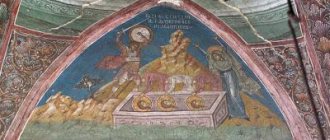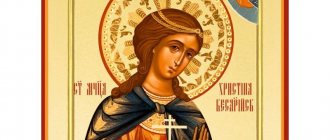Home › Name day
Nadezhda is a name that is of Slavic origin. It comes from the ancient Greek martyr Elpis - Nadezhda, who, along with her sisters, Faith and Love, was martyred for obeying the commandments of Jesus. Previously, the name Nadezh was popular, and only in the ninth century was the modern form of this name, which translates as “to hope,” formalized. Nadezhda is a very patient and purposeful person who has qualities such as fairness, perseverance and restraint. She values fidelity and openness in men.
| Full name: | Hope |
| Church name: | Hope |
| Meaning of the name: | from the ancient Greek name Elpis - “hope” |
Nadezhda's name day dates in 2021 according to the Orthodox calendar
| March | |
| March 14th | Nadezhda Abbakumova, martyr |
| 20th of March | Nadezhda Kruglova, Venerable Martyr |
| September | |
| September 30th | Nadezhda of Rome, martyr, youth |
| October | |
| October 21 | Nadezhda Azhgerevich, martyr |
Patron Saints
Until the beginning of the 21st century. The patron saint of girls named Nadezhda was a holy youth who lived in the 2nd century. But the modern Russian Orthodox Church at the beginning of this century canonized several righteous women who suffered for the Faith during the Soviet persecution of religion.
Nadezhda Rimskaya
At the beginning of the 2nd century after the birth of Jesus Christ, the pious widow Sophia lived in Rome, who raised three daughters: Faith, Hope and Love. The mother raised in the girls a love for the Lord, taught them to boldly declare their beliefs and not be afraid of losing earthly goods. Emperor Hadrian, who was a staunch opponent of the new Faith, became aware of the family openly professing Christianity.
Congratulations to Nadezhda on her name day
Happy name day to you, Nadya! May everything be covered in chocolate. I wish you female happiness, to know neither grief nor bad weather. May your friends be by your side, May your life be rich and colorful. I wish you to see the world, be grateful to fate for everything!
In your name, Nadezhda, there is a lot of faith, a lot of heart! I’ll congratulate you on your name day and deliver the fun on time! May the Lord protect you from troubles, May there be an answer to everything! I wish you happiness and joy, I respect you very much!
You are always in anticipation of good things. You are Hope, and that says it all. Let everything in your destiny be folded the way only you want, my dear. After all, today is Good Angel Day for you, dear Nadyusha, Let him hug you tenderly, Sing a song of happiness, and you listen.
Today the angels are trumpeting: It’s Nadya’s name day! You need to congratulate such a sweet lady from the bottom of your heart. Nadyushka, Nadenka, Nadezhda We wish you happiness as before, a sea of smiles and love, so that misfortunes go away! We cordially congratulate Nadya and on her name day we wish her that her soul may bloom, that an angel will always be near her and drive away failures and bless her on a good path. Looking at you, beauty, we say: “Happy Angel Day, Nadya.”
Dear Nadezhda! Happy Angel Day! May your cherished wishes come true. Enjoy every day of your life. Let only positive emotions go to your head. Love to you, our beauty, and happiness!
Meaning and characteristics of the name
Girls have been called Nadezhda for a long time. This Old Church Slavonic name originates in Greece . The meaning is the same as the Greek Ellis and means “reliable.”
The bearer of the name has such qualities as secrecy and acting abilities, which helps her achieve her goals and make profitable acquaintances. She always carefully considers what and when to say and how to act. Outwardly, she seems to be a carefree, carefree person, but inside she is calculating, with a tough character.
Little Nadias are stubborn girls who do not make concessions and are capricious. Teenagers love different parties, never missing a single one. Always sociable and cheerful. They study well.
As a young girl, Nadezhda dreams of true love with confessions, gifts and surprises. But as he grows up, he leaves his dreams behind. In relationships with the opposite sex, she can be emotional, but she does not express recognition or kind words. Well-groomed, always looks impressive, has impeccable taste.
Nadya gets married for love, which cannot withstand everyday problems. Therefore, usually the first marriage is not the only one. But if a woman feels the reciprocal feelings and warm attitude of her husband, then she becomes an excellent mother for her children and devotes herself entirely to her family and home. A woman with a masculine character, Nadya leads her husband so skillfully that he does not even notice it.
Nadya has many friends and acquaintances, but none of them are real. After all, she is secretive and does not share her secrets with anyone. She can show herself as an adventurer, and sometimes as a fraudster. Negative qualities of Hope:
- talkativeness, in which she can blurt out the secrets of acquaintances without meaning to;
- excessive conceit;
- tendency to intrigue in a team.
But a woman also has positive qualities, such as reliability and efficiency. Nadi have a strong character, always go towards their goals and strive to take a leading position among their peers.
Throughout her life, Nadezhda has been trying to devote as much time as possible to education. Signs up for many trainings and clubs at the same time, but does not listen to them to the end due to simple laziness.
What to give for Nadezhda’s name day?
Since she loves to decorate the house, you can give her a gift that will become a talisman, namely an icon embroidered with your own hands or wax candles, or a lamp for home prayer. Coral is a talisman stone for Nadezhda, so you can give her coral jewelry. The patron animal of the name is the dog. The girl will be very happy to receive a puppy or a figurine in the form of this animal as a gift. You can also give a gift for health in the form of cream or soap with calendula, the treasured plant of Hope.
Health and innate abilities
The mystery of the name suggests a restless child who refuses his mother's breast early. She needs to be fed, but with caution so as not to spoil her stomach. Nadenka has a predisposition to respiratory diseases and respiratory tract diseases. It is not recommended to name a girl after a relative.
photo: pixabay.com
Nadya is developing very rapidly. She is not afraid of communicating with strangers. A girl born in summer has a weakened immune system. Nadyusha gets sick most often in the summer.
- At school he often gets the flu.
- There is a predisposition to infectious diseases.
- You can get chickenpox when you are old enough.
- A girl born in spring is susceptible to skin ailments.
Nadezhda is a sensitive person and takes everything to heart. She constantly needs attention from her parents. She often feels lonely and withdraws into herself. You should not allow Nadenka to be alone often, because this will ruin her character. Diseases of the legs and gynecological line begin to torment Nadezhda in adulthood.
Famous Hopes and their angel day
Prominent bearers of this name are the famous opera singer Nadezhda Ivanovna Zavela-Vrubel and Nadezhda Durova, actress Rumyantseva and singers Babkina and Kadysheva. And in Soviet times, the most famous and respected was Nadezhda Krupskaya.
Each specific Nadezhda has the right to celebrate her name day (angel day) once a year - on the day closest to her baptism of the saint bearing that name. But still, the most famous, often considered the only one, is the day of remembrance of the four Roman martyrs, September 30. During the wonderful time of golden autumn, all bearers of these beautiful holy names accept congratulations on Angel’s Day. Hope, Love, Faith are “three virtues, like holy angels.”
Dependence of the name on the season
A girl born in winter is a taciturn and shy person. Nadezhda, who celebrates her birthday in the spring, is a slightly selfish and emotional girl. “Summer” Nadya is distinguished by her poise and determination. A beautiful female representative, born in the fall, is a hardworking and persistent person.
Martyr Nadezhda Azhgerevich
Hieromartyr Demetrius (Dobroserdov), Holy Martyrs Ambrose (Astakhov), Pachomius (Turkevich) and Varlaam (Efimov), Holy Martyr John Khrenov, Holy Martyr Tatiana (Familyless), Martyr Nikolai Rein, Martyrs Maria Volnukhina and Nadezhda Azhgerevich
Hieromartyr Dimitri (in the world Ivan Ivanovich Dobroserdov) was born on January 22, 1864 in the village of Pakhotny Ugol, Tambov province, into the family of a priest. After graduating from the Tambov Theological Seminary in 1885, he was appointed teacher of the zemstvo school in Morshansky district, where he worked until 1889. During this time, he repeatedly received gratitude from the Morshansky Zemstvo Assembly and the Tambov Provincial School Council for his diligent and successful work in the field of public education. Got married. On May 6, 1889, Ivan Ivanovich was ordained a priest to the St. Nicholas Church in the village of Mamontovo, Tambov province, which then had a population of about two thousand people, and was appointed head and teacher of the law at the Mamontov parochial school. Soon, Father John’s wife and children died. Left alone, he left the Tambov province and in 1894 entered the Moscow Theological Academy. Upon graduating in 1898 with a candidate of theology degree, he was appointed teacher of the law at the 4th Moscow Gymnasium and priest of the gymnasium church. On April 10, 1899, Metropolitan of Moscow and Kolomna Vladimir (Epiphany) appointed Priest John rector of the Annunciation Church at the gymnasium. In the same year, the Pedagogical Society at the Imperial Moscow University elected him as its full member, and the branch of the Pedagogical Society for Religious and Moral Education and Upbringing elected him as its secretary. On May 6, 1908, he was awarded a pectoral cross for his services in the spiritual department. At this time, Metropolitan Vladimir of Moscow invited Father John to his place and said: “Father John, we basically have two paths: the family path and the monastic path. The family path is closed to you. I advise you to take monasticism.” Father John agreed and in December 1908, in the Smolensk Zosimova Monastery of the Moscow Diocese, he was tonsured a monk with the name Dimitri, elevated to the rank of archimandrite and appointed synodal sacristan and rector of the Church of the Twelve Apostles in the Kremlin. In 1909, Archimandrite Dimitri was appointed observer of the novitiate schools of the stauropegic monasteries. In 1910, he was elected a full member of the church-archaeological department of the Society of Lovers of Spiritual Enlightenment. At this time, he was also a full member of the Guardianship of the Slavs studying in Moscow of the St. Petersburg Slavic Charitable Society. On May 18, 1914, in the Assumption Cathedral of the Kremlin, Archimandrite Dimitri was consecrated Bishop of Mozhaisk, vicar of the Moscow diocese and appointed rector of the Savino-Storozhevsky Monastery. From the same year, he began to serve as head of theological pedagogical courses in Moscow. At the same time, he was entrusted with the main leadership and supervision of the publication of a scientific, artistically illustrated description of the Patriarchal Sacristy. In 1921, His Grace Dimitry was appointed Bishop of Stavropol. Renovationists in the Stavropol diocese won an almost complete victory over the Orthodox, who lost the majority of their parishes. One of the reasons for this was the mass extermination of the clergy during the Civil War era in 1918-1921. Under the pressure of the Renovationists, Bishop Demetrius was forced to leave the diocese and move to Moscow. In 1922, the Orthodox Christians of the Tambov diocese waged a stubborn struggle against the Renovationists. At first, the renovationists managed to capture most of the churches in some cities. In the city of Kozlov, fourteen churches went to the renovationists, only two churches remained Orthodox. The Orthodox people, however, did not visit renovationist churches, but went to the Trinity Monastery, located three kilometers from the city. After Patriarch Tikhon was released from prison in 1923, the diocesan council of the city of Kozlov sent its representatives to Moscow with a request to appoint an Orthodox bishop to them. On September 26, 1923, the Right Reverend Dimitry was appointed Bishop of Kozlovsky, vicar of the Tambov diocese and temporary administrator of the Tambov diocese. After the arrival of Right Reverend Demetrius in the city, the Renovationists brought repentance and all the churches, with the exception of one, passed to the Orthodox. His Eminence Demetrius served in all the churches of the city; he was a wonderful preacher. Over time, his popularity among Orthodox Christians grew more and more. The renewal movement in the diocese was threatened with complete defeat. The representative of the Tambov department of the OGPU for the Kozlov district wrote: “At the head of the Tikhonov movement in the city of Kozlov and the district, as well as the entire Tambov province, is Bishop Dimitri, a very cunning and cautious man, who enjoys enormous authority among believers, and especially among kulaks and the dark element. Bishop Dimitri very cunningly pursues a policy of appointing his priests to the places occupied by the priests-renovationists, that is, the priest who turns to him for an appointment, he offers to go to the village and get from a group of believers a protocol decree about the desire to have a priest sent by Bishop Dimitri in the parish; Of course, with this approach to the matter, the sent priest has no choice but to conduct agitation against the priest in the parish, accusing him of heresy, communism, and the like. Since the abolition of the Diocesan Administration, all power has passed into the hands of Bishop Demetrius... to whom... the priests obey, since otherwise, one who disobeys with the help of the agitation of the priests sent by Demetrius risks losing his place and turning into a heretic. Thanks to the authority and politics of Dmitry, the Tikhonov movement in the city of Kozlov and the district is growing by leaps and bounds. The greatest evil for the renovationist movement are also monks, whose appointment Demetrius denies, citing the fact that he has nothing to do with this either, since monks, again, are the chosen ones of the people. The return of the Pyatnitskaya city of Kozlov church by order of the All-Russian Central Executive Committee to the Tikhonites from the renovationists made it possible to further raise the heads of the Tikhonites and further strengthen their authority, in particular the authority of Bishop Dimitry... And up to 90% of the entire clergy, followers of the former Patriarch Tikhon, are in the city of Kozlov and the district. In the field of work among the clergy, we have taken the following measures: an urgent registration of all clergy is being carried out, measures are being taken to terminate the contracts of Tikhonov-type groups in favor of the Renovationists... It is planned to create a Diocesan Administration with an equal percentage of Tikhonovites and Renovationists...” During Lent of 1925, Bishop Dimitri began to be frequently summoned for interrogation at the OGPU. Sometimes after interrogations he immediately went to the temple, where they were waiting for him to begin the service. The authorities insisted that the ruler leave Kozlov, but he refused. They began to threaten him with imprisonment. In the end, citing a heart condition, he asked the authorities to release him to Egypt for treatment. He was issued a foreign passport, and he went to the British embassy in Moscow to obtain permission to enter the then British colony. Having successfully completed all the documents, the Right Reverend Dimitry went to Sergiev Posad the next day to say goodbye to Alexander Dmitrievich Samarin, who was once the Chief Prosecutor of the Holy Synod, with whom the Bishop was on friendly terms. On the way to Samarin's house, he was stopped by a horseman, and the bishop was arrested. From the prison in Sergiev Posad he was sent to the Lubyanka prison in Moscow, where he spent a week, and then was released with orders to go to Kozlov. In Kozlov he was arrested and taken to Tambov. In Tambov, Bishop Dimitry was released from prison and went to Moscow, where he had the opportunity to concelebrate with the Locum Tenens of the Patriarchal Throne, Metropolitan Peter, at the all-night vigil on the eve of the celebration of the memory of the Great Martyr Catherine. This was the last service for the Locum Tenens; three days later he was arrested. In 1926, Bishop Dimitri served in Moscow churches and in the Moscow region. In July 1926, the OGPU commissioner Tuchkov summoned the bishop and demanded that he leave the capital. Citing a bad heart, the bishop said that he would leave for Kislovodsk. Before leaving, Bishop Dimitri went to the Deputy Patriarchal Locum Tenens, Metropolitan Sergius (Stragorodsky), who, due to the extraordinary circumstances of governing the Church in conditions of incessant persecution, divided the Stavropol diocese into two and entrusted Bishop Dimitri with the management of the newly created Pyatigorsk diocese. Vladyka settled in Kislovodsk, where he rented a room in an area called Ryabova Balka, on the outskirts of the city behind the railway station, not far from the Panteleimon Church, in which he often served. On April 14, 1932, Bishop Demetrius was elevated to the rank of archbishop. On March 23, 1934, he was appointed Archbishop of Mozhaisk, vicar of the Moscow diocese. In Moscow, Vladyka settled in the gatehouse at the Elias Church on Bolshaya Cherkizovskaya Street, where he lived until his arrest. Archbishop Dimitry was arrested on September 29, 1937 and imprisoned in Butyrka prison. Immediately after the arrest, interrogations began, which on October 9 were formalized in the form of a protocol and signed by the archbishop. Archbishop Demetrius did not plead guilty and did not agree to incriminate anyone. – The investigation has evidence that you, among those around you, stated that there was persecution of religion and the clergy in the USSR. Do you confirm this? – the investigator asked. “I do not confirm this, and I have not announced this to anyone,” answered the archbishop. – The investigation knows that you spread counter-revolutionary provocative rumors that Metropolitan Peter was allegedly shot by the Soviet authorities. How do you know this? – I know from Metropolitan Sergius (Stragorodsky) that Metropolitan Peter died in exile in December 1936, but I did not hear from anyone about his execution and did not spread such rumors. Along with Archbishop Dimitri, Archimandrite Ambrose (Astakhov), Abbot Pachomius (Turkevich), Deacon John Khrenov, monk Varlaam (Efimov), nun Tatyana (Besfamilnaya), laymen Nikolai Rein, Maria Volnukhina and Nadezhda Azhgerevich were arrested.
The Venerable Martyr Ambrose (in the world Alexey Anikeevich Astakhov) was born in 1860 in the village of Borisovka, Lebedyansky district, Tambov province, into a peasant family. Until 1925, he lived in the monastery, and after its closure, in various villages of the Moscow region, in particular in the village of Aksinino, Krasnogorsk district, and spiritually cared for the nuns and novices of the Golovinsky monastery. – Who visited you at your apartment and for what purposes? – the investigator asked. “I was visited by my admirers who turned to me for various advice,” answered Archimandrite Ambrose. – What advice did you give to your fans? – I gave advice only on matters of family life. – The investigation has evidence that you treated your admirers in an anti-Soviet spirit. Do you confirm this? – Yes, I really said that the Soviet government persecutes religion and the clergy, I said that the Soviet government is the power of the Antichrist, sent to punish the people for their sins. – Explain your views on Soviet power. – I am hostile to the Soviet government, I believe that the Soviet government destroys churches, exiles completely innocent clergy and believers. According to my convictions, I am a monarchist, and I view Soviet power as a temporary phenomenon... People in Russia, who through their stupidity overthrew the tsar, now repent of this, because they see a lot of injustice from the Soviet government, which did not happen under the tsar.
The Venerable Martyr Pachomius (in the world Pavel Akimovich Turkevich) was born in 1864 in the town of Milyanovichi, Kovel district, Volyn province, into the family of a blacksmith. He labored in the Chrysostom Monastery until its closure in 1923. In the late twenties and early thirties, being in old age, he lived in Moscow with his spiritual children. “Your attitude towards the Soviet government,” the investigator asked Abbot Pachomius during the interrogation. – I consider the Soviet government to be the power of the Antichrist, which was sent by God to the people as punishment.
Hieromartyr John was born on September 3, 1888 in the city of Moscow into the family of Semyon Khrenov, an employee of the Tagansk prison. The family was very religious and pious. From early childhood, Ivan went to pray at the Novospassky Monastery, located not far from the house where they lived. Over time, he began to sing in the choir along with the monks and was a reader at some services. In 1907, Ivan Semenovich graduated from the Pedagogical Institute, but did not become a teacher; he did not feel a calling to this profession and saw that he was faced with great difficulties in explaining educational material to children. He first got a job as an accountant in the Tagansk prison, and then Hieroschemamonk Aristokliy, with whom Ivan Semenovich was well acquainted, helped him get a job as an accountant in the Moscow Merchant Bank. In 1911, Ivan Semenovich married the girl Evdokia. She was from a pious family and a parishioner of the Novospassky Monastery, where they met. After the nationalization of banks in 1917, Ivan Semenovich began working as an accountant in government agencies in Moscow. After the closure of the Novospassky Monastery, he, like all the parishioners of the monastery, began to go to the Church of the Forty Martyrs located next to the monastery; there he was offered to accept the rank of deacon. The choice was very serious, and Ivan Semenovich went to the Church of St. Nicholas on Maroseyka to Archpriest Alexy Mechev to consult with him and take a blessing. Father Alexy blessed, and in 1921 Bishop Hilarion (Troitsky) of Vereya ordained him to the rank of deacon at the Church of the Forty Martyrs. At that time there was still a Sunday school at the church, which Deacon John began to lead. He served here for about a year; At that time, strife began in the temple, and he left it. Then he served for some time in the Trinity Church in Kotelniki. While serving in the Church of the Forty Martyrs and in the Trinity Church, Deacon John continued to work as an accountant. Father John's family, consisting of his wife and daughter, was friendly; They devoted all their free time on weekdays to reading spiritual books, and especially the lives of saints, reading the lives of every day. On Sundays and holidays, and whenever possible, they went to church. At the beginning of the 1930s, Father John was summoned to the OGPU and told him: “You are a good worker, we checked you, we offer you to work as an agent for us, inform us about everyone who works with you.” Father John answered this: “I cannot do this, because I have the rank of deacon.” - And you will remove yourself from the rank of deacon. “God gave it, God will take it away from me,” answered Father John. The OGPU employees did not insist any further, and one of them said: “We would like more such persistent people.” In 1937, it was reported to Deacon John that many clergy were visiting his apartment, and they came to search and arrest him. During the search, they found a certificate stating that he had been ordained to the rank of deacon. “Well, here’s another thing,” one of the searchers said with satisfaction. During interrogations, Father John confirmed that he still holds the rank of deacon and does not want to remove the rank. As for the accusations of counter-revolutionary activities, he does not plead guilty to this.
The Venerable Martyr Varlaam (in the world Vasily Sevastyanovich Efimov) was born on April 12, 1903 into the family of pious Moscow residents Sevastyan and Mavra Efimov. He worked as a courier in the 33rd police station. In 1935, he secretly took monastic vows with the name Varlaam. He was arrested on September 29, 1937. He was accused of being “hostile towards the Soviet regime and conducting systematic anti-Soviet agitation among those around him. He provided his apartment for secret services and overnight accommodation for the clergy returning from exile. In 1935, he took monastic vows as a secret monk, to which he persuaded his other like-minded people.” The investigator asked him how the priestly vestments got into his apartment. Vasily Sevastyanovich replied that it was left by Hieroschemamonk Aristoklius, whom his entire family deeply revered and who performed prayer services in their apartment several times. But “at this time he is no longer alive, since he died about five years ago,” explained Vasily Sevastyanovich. He pleaded not guilty to anything. On October 17, 1937, the NKVD troika sentenced monk Varlaam (Efimov) to ten years in prison, and he was sent to Lokchimlag in the Komi region, where he soon died.
Venerable Martyr Tatiana ( Tatyana At the age of five, she was given by her mother to the orphanage of the Nativity Monastery, where she lived until its closure in 1923, without leaving the monastery all this time. Having labored in various obediences, she graduated from a parochial school in a monastery. In 1920, Tatyana took monastic vows. After the monastery was closed and until her arrest, she lived in an apartment not far from the monastery, continuing to perform her monastic feat, earning a living by handicrafts and sewing. After being arrested, she pleaded not guilty.
Martyr Nicholas was born By birth, Alexander Rein was a Prussian subject who came to Russia as an estate manager, but in 1903 he accepted Russian citizenship. In 1911, Nikolai Alexandrovich graduated from the Kreiman gymnasium, and in 1918 from the Agricultural Institute. From 1920 to 1930, he worked as a researcher at the Timiryazev Academy in Moscow, and then, until the day of his arrest, at the Institute of Vegetable Farming. During the persecution of the Church by the godless authorities, he sheltered the Athonite hieromonk Hilarion (Gromov) in his house and provided him with financial assistance. – The investigation has evidence that you spread provocative rumors among believers about the alleged persecution of religion in the USSR. Do you confirm this? “I don’t deny that I could talk about the existing persecution of religion, but I didn’t spread provocative rumors among believers,” answered Nikolai Alexandrovich. “The investigation has evidence that a secret worship service was held in the apartment of you and parishioners you knew. Do you confirm this? “Neither I nor those close to Priest Hilarion had a secret service. I do not deny that services were held in the apartment of me and my friends, but this was associated with the performance of a number of religious rituals (funerals, holiday prayers, etc.). – Your beliefs and views on Soviet power. – I consider the Soviet government to be a legitimate government, but it does not take into account the worldview of believers, it fights against religion and the Church as counter-revolutionary organizations...
Martyr Maria ( Maria Nikolaevna Volnukhina) was born on March 3, 1876 in Moscow into the family of a merchant. She married manufacturer Ivan Gerasimovich Volnukhin. Both were deeply religious people for whom faith was the main value and content of life. Soon after the revolution, Maria Nikolaevna lost her husband. In 1927, all its property was nationalized. In 1932, Maria Nikolaevna was sentenced to three years of exile in the Northern Territory, in the city of Kotlas, but soon left there and from that time began to wander, without a specific place of residence. She was revered among believers for her ascetic life and foresight. After being arrested, she pleaded not guilty. – On what means did you exist? – the investigator asked her. “I lived on the money I received from begging. – Where did you live after your return from exile? – I did not have a specific place of residence, I lived with my friends, whom I refuse to name.
Martyr Nadezhda was born She was a deeply religious person, had a blessing to become a monk, but did not have time to take monastic vows. She did not have her own home and lived with nuns of closed monasteries in Moscow and the Moscow region. After being arrested, she pleaded not guilty. – What did you do and on what means did you exist? – the investigator asked. – I am without certain occupations, wandering and begging. – The investigation has evidence that you collected money among believers to provide material assistance to those expelled for counter-revolutionary activities. Do you confirm this? “I do not deny that I provided financial assistance to those arrested from the funds that I managed to collect. – Did you spread rumors about an alleged famine in the USSR? – I didn’t say this, without me everyone saw how hungry people who had come from Ukraine were sitting outside the churches, begging for food. – Have you spread provocative rumors about the alleged persecution of religion and the clergy in the USSR? – Yes, I said that the Soviet government arrests innocent people, commits outrages and shoots innocent people. – Name your admirers who provided you with accommodation for the night. “I received lodging for the night from my admirers, but their names and addresses are unknown to me. On October 17, 1937, the NKVD troika sentenced those arrested to death. On October 21, Archbishop Dimitri (Dobroserdov), Archimandrite Ambrose (Astakhov), Abbot Pachomiy (Turkevich), Deacon Ioann Khrenov, nun Tatiana (Besfamilnaya) and laymen Nikolai Rein, Maria Volnukhina and Nadezhda Azhgerevich were shot at the Butovo training ground near Moscow and buried in the general unknown grave.
Compiled by Hegumen Damascene (Orlovsky)
“Lives of the new martyrs and confessors of the Russian 20th century of the Moscow diocese. September October". Tver, 2003, pp. 129-149.
Bibliography
GARF. F. 10035, house 20816. RGIA. F. 796, op. 439, no. 320. GATO. F. R518, op. 1, no. 230. Reference and memorial book on the Tambov diocese for 1893. Kozlov, 1893. Composition of the Holy Governing All-Russian Synod and the Russian Church Hierarchy for 1917. Petrograd, 1917. Moscow magazine. 1991, No. 12. Those who suffered for Christ. Persecution of the Russian Orthodox Church. 1917-1956. Book 1. M., 1997. Artamonov V.B. Archbishop Dimitry (Dobroserdov, 1864-1937): materials for a biography. Manuscript. 1998. Damascene (Orlovsky), abbot. Martyrs, confessors and devotees of piety of the Russian Orthodox Church of the 20th century. Book 5. Tver, 2001.
Source: https://www.fond.ru/
Holiday customs
On this holiday it is necessary to visit the church and listen to the corresponding liturgy. Pray to the holy martyrs and place two candles near the icon, and take the third one home. They ask the martyr Nadezhda for protection, health and well-being.
People believed that on this day any girl had to start the morning crying. This explains the second name of the holiday - “the cry of all women.” Sad and crying, each girl paid tribute to the martyrs: saints Vera, Nadezhda, Lyubov and Sophia.
On the holiday, it was necessary to bake a loaf of bread and place a candle in the center. And while eating, preferably at dinner, place the cooked product in the middle of the table. It was believed that in this way Sofia and her daughters could protect the family from evil spirits and evil.
What is Nadezhda’s name day? Nadezhda Abbakumova (March 14)
According to the church calendar, Nadezhda celebrates her angel day 4 times a year: March 14, March 20, September 30, October 21. The patron saints of the name are four martyrs who lived at different times and whom the church remembers precisely on these days.
In March, on the 14th, a woman named after Nadezhda Abbakumova celebrates her name day. She was a simple peasant woman who faced severe trials. But the woman did not lose faith in God, but carried it throughout her life, accepting martyrdom at the end of her earthly journey.
Nadezhda Abbakumova was born into a peasant family in one of the villages of the Moscow province in 1880. At the age of 19 she got married and gave birth to four children. During the revolution, Nadezhda was widowed. She had to raise her children alone. At the same time, persecution of the church began, but Nadezhda Abbakumova remained a true Christian. In 1928 she was elected churchwarden, collecting money and food for the priest and paying taxes.
Nadezhda Abbakumova was arrested on March 2, 1938, because, according to investigators, she was conducting anti-Soviet propaganda, and on March 14 she was shot. It is on this day that Nadezhda’s name day is celebrated according to the church calendar. And in 2000, the woman was canonized among the Russian new martyrs.









